Temperature Measurement - Thermisters, RTD, & Thermocouples
Introduction
Hello, welcome back to my BLOG. This post includes common methods to sense temperature along with some history of the units we use to give the measurement meaning. The scope is on contact measurements with temperature sensors. The next post will include non-contact measurements with pyrometry. If you need a primer see my prior post on heat energy and temperature.
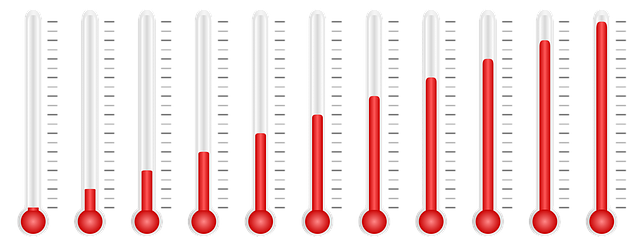
Image Source CC0
Overview
There are many reasons to measure temperature and many different tactics to gather the information. As mentioned in my last post temperature is a measure of heat energy. There are numerous reason to collect and analyze temperature. It could be as simple as monitoring the ambient temperature outside, or as complex as gathering temperature data for an experiment or a control loop. Temperature can be sampled and analyzed in real-time, or acquired and logged for analysis.
In the last post we established that heat is energy and that temperature is a measure of heat. Before we dive into various contact measurements lets look at the units for temperature. Temperature is usually represented in terms of the number of degrees referenced between two points. Here in the United States we use degree Fahrenheit when discussing the weather and for setting our ovens. However when doing experiments and collecting data, I almost always use degree Celsius, like the rest of the world. Here in the US we use both F and C, or have to keep up with both standard (United States customary units) and metric measurements.
One could dedicate an entire post on metric versus other standards, and another on the history of the units for temperature. Let us keep it simple and refer to metric as a base 10 system, while the other standards use fractions.
Units of Measure
In 1724 Daniel Gabriel Fahrenheit, physicist and inventor used the coldest solution he could make in his lab for a 0 degree reference, and his body temperature for a 96 degree reference. He used the reference points to determine that water will freeze at 32 °F, and boil at 212 °F. Why use 96 for the upper end of the measurement rather than 100? I am not alone in asking, and according the the research I did, he used 96 to make it easy to divide his measurement into 12 equal parts. Standards at the time were using fractions, just as 1 foot is divisible into 12 inches.
Note: Body temperature is actually considered 98.6, so his scale may not be linear, or maybe he was subnormal at the time of measurement. I find it interesting that the difference between the boiling point of water and the freezing point of water are 180 degrees apart on his scale.

Image Source: 85fce (Own work) CC BY-SA 3.0, via Wikimedia Commons
In 1742, Swedish astronomer Anders Celsius referenced the freezing point of water as a 100 degree point, and the boiling point of water as the 0 degree point. In 1744, coincident with Celsius death, the Swedish botanist Carl Linnaeus (1707–1778) reversed Celsius's scale such that 0 was the reference for freezing and 100 for boiling.
Another unit worth mentioning, well they are all worthy but I have the time for one more and that is the Kelvin scale. In 1848 engineer and physicist William Thomson, 1st Baron Kelvin proposed an absolute scale with a null at absolute zero. He found absolute zero, the theoretical temperature where there is an absence of all heat energy and calculated the value as −273.15°C.
Methods of Measure
Now we have defined the units of measure, lets look at how temperature is measured. This post has emphasis on contact measurement that are used in electronics. I considered adding electromechanical devices like thermostats but have decided to focus on resistive and electronic components, particularly sensors that I have experience with.
Contact measurement sensors are in physical contact with the object being measured and use conduction for the primary type of measurement. A contact measurement is typically less complicated and more economical that a non-contact measurement.
Non-contact measurements use the emitted IR energy to determine temperature. They are faster and allow the measurement of higher temperatures. Non contact also provides several advantages including being able to measure moving objects like parts on a conveyor belt. Non contact measurements also allow the sampling of the temperature without changing the object being measured, as it measures the heat energy from light. I plan to discuss pyrometry, a form of non contact temperature collecting in more detail in a future post.
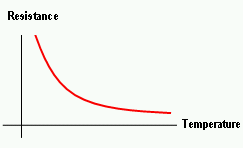
Image Source: Theresa knott CC BY-SA 2.5, via Wikimedia Commons
There are many types of sensors for contact measurement of temperature. The properties of electrical and electronic components are affected by a change in temperature. This change is known as the temperature coefficient, and unless used as a sensor it is better when the coefficient is low. Temperature sensors have a temperature coefficient that is either positive or negative, and the greater the coefficient the more sensitive the sensor. A lot of temperature sensors use a change in resistance to electrical current to measure temperature. If the device has a positive temperature coefficient (PTC) then resistance will increase with an increase in temperature, where a device with a negative temperature coefficient (NTC) will reduce resistance as temperature increases. The plot in the image above shows a NTC.
Thermister
A thermistor is an example of a component designed to change resistance with a change in temperature. Thermistors are available with both a NTC or PTC. The polyswitch, known as a resettable fuse is an example of a thermister with a PTC. The polyswitch is used in electronic circuits to prevent over current. When the current increases the polyswitch heats up in a process knows as self-heating, causing the resistance to increases and reduces the current. When the current stops flowing the polyswitch cools down and resets. It is knows as a resettable fuse because it opens like a fuse when current is too high, but will automatically close when the short circuit condition is corrected.
Polyswitch
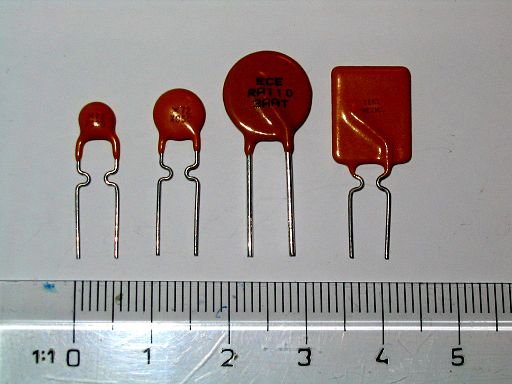
Image Source CC0
Thermistors are generally made from ceramic materials or polymers. They tend to be useful over a small range of temperatures but act fast and are both accurate and sensitive.
Resistance Temperature Detector or RTD
Another type of electrical component that is used to measure temperature is the Resistance Temperature Detector or RTD, also known as Resistance Thermometers. RTD’s are precision temperature sensors made from high-purity conducting metals such as platinum, copper or nickel wound into a coil and whose electrical resistance changes as a function of temperature. While not as sensitive as a thermister the RTD output is more linear, producing very accurate measurements over a wide range. The materials used to produce RTDs make them more expensive.
Platinum Resistance Thermometer (PRT)
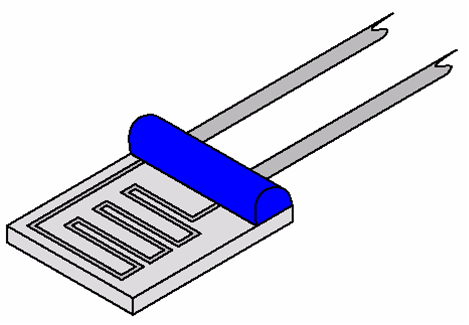
Image Source CC0
As mentioned all electrical and electronic components have a temperature coefficient, and unless used as a sensor the smaller the better. Semiconductors used in diodes have junction properties that change conduction with temperature, so diodes make good temperature sensors. For example CPUs typically have a diode integrated into the circuit such that the temperature of the chip can be monitored.
The devices mentioned thus far scale temperature by passing current through the component, and read the change in voltage or current because of the temperature coefficient of resistance. In other words they use Ohm's Law (V = I * R), where V is voltage, I is Current, and R is resistance. All of the devices above have a dynamic resistance that changes when there is a change in temperature.
Thermocouple
Thermocouples consist of dissimilar metals that connect at a bead, known as the hot junction. They measure temperature at the hot junction. Rather than changing electrical resistance, thermocouples use a property known as the Seebeck effect.
In 1821, physicist Thomas Johann Seebeck found when different metals are joined at the ends and there is a temperature difference between the joints, and a magnetic field is observed. At the time Seebeck referred to this as thermo-magnetism. The magnetic field he observed was later shown to be due to thermo-electric current. In practical use, the voltage generated at a single junction of two different types of wire is used to measure temperature at very high and low temperatures. The magnitude of the voltage depends on the types of wire used. The voltage is in the microvolt range and care must be taken to obtain a usable measurement. Although very little current flows, power can be generated by a single thermocouple junction.
The type of dissimilar metal determines the range of temperature that can be measured, and the sensitivity of the output. The output is a very small voltage that is proportional to the temperature.
Thermocouple
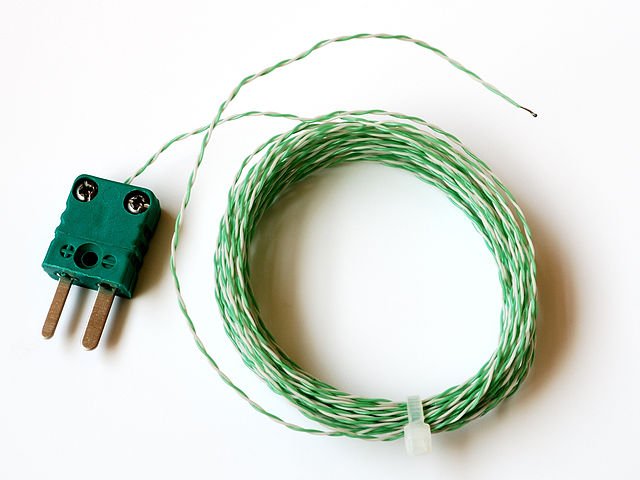.jpg)
Image Source CC0
Thermocouples are very accurate, but not as accurate as higher end RTDs. However they are less expensive and more robust for use in industrial applications. They are practical and popular because of their performance. The type of thermocouple is determined by the type of metals used to make the hot junction. Thermocouples are available in different combinations of metals and calibrations. The most common are the “Base Metal” thermocouples known as Types J, K, T, E and N. There are also high temperature calibrations - also known as Noble Metal thermocouples - Types R, S, C and GB.
When using thermocouples care must be taken to use the correct wire and connectors, as each type has conductors and connectors made with the same materials as the junction.
Type K
Type K (chromel–alumel) is the most common general-purpose thermocouple with a sensitivity of approximately 41 µV/°C. It is inexpensive, and a wide variety of probes are available in its −200 °C to +1350 °C (−330 °F to +2460 °F) range.
Here is a list with all thermocouples types and a color coded charts from Omega.com. They are also an excellent resource for learning more. The thermocouple hardware and cables are color coded. For example the K-Type typically uses a yellow connector and cable. The cable has a red (-) wire for the chromel, and a yellow (+) wire for the alumel. The connectors are keyed and come in standard sizes to help with design and replacement.
CJC – Cold Junction Compensation
As mentioned care must be taken to use the correct wire for the thermoouple. At some point the connection is made to a copper circuit board or a connector. At the point of contact with a dissimilar metal junction there is an error voltage created by the effect. This error has to be corrected. It is possible to compensate for the error by bathing the cold junction in an ice bath, and perform a calibration procedure. CJC corrects the error temperature at the cold junction by using a reference. Modern instruments have CJC built in and use a thermister to measure the ambient temperature inside the instrument at the point of contact, so the ice bath is not required. Once the signal has been compensated, it can be transmitted, filtered, and amplified for measurements.
Thermocouple measurement system
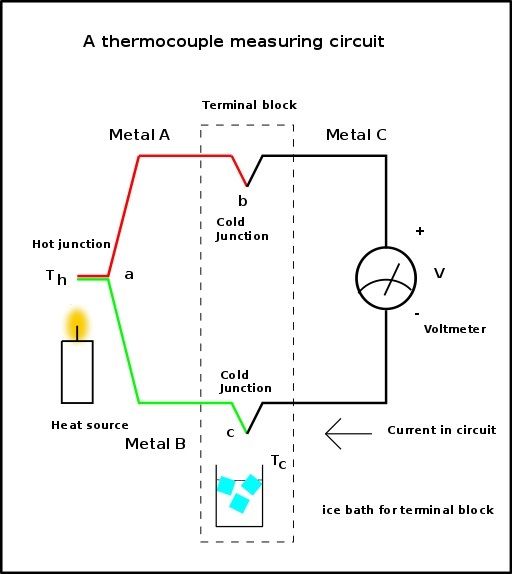
Image Source: Wtshymanski at English Wikipedia CC BY-SA 3.0
Conclusion
This concludes the post on measuring temperature by means of sensors that make contact. I hope you enjoyed the background on units of measure, and the emphasis placed on: thermisters, RTDs, and thermocouples. Stay tuned for non-contact measurement devices like pyrometry!
Sources
All sources reflect state of website in Feburary 2018
https://en.wikipedia.org/wiki/Temperature
https://en.wikipedia.org/wiki/United_States_customary_units
http://mathforum.org/library/drmath/view/52561.html
https://www.electronics-tutorials.ws/io/io_3.html
https://en.wikipedia.org/wiki/Thermistor
https://www.omega.com/prodinfo/thermocouples.html
https://en.wikipedia.org/wiki/Thermocouple#Physical_principle:_Seebeck_effect
Pleas let me know if you have any comments and questions. Thanks for reading, and please consider liking and following. Do you have an interest in pyrometry (IR temperature measurement)?
All feedback and recommendations are appreciated. Thanks! --3D
Special thanks to everyone from #SteemSTEM